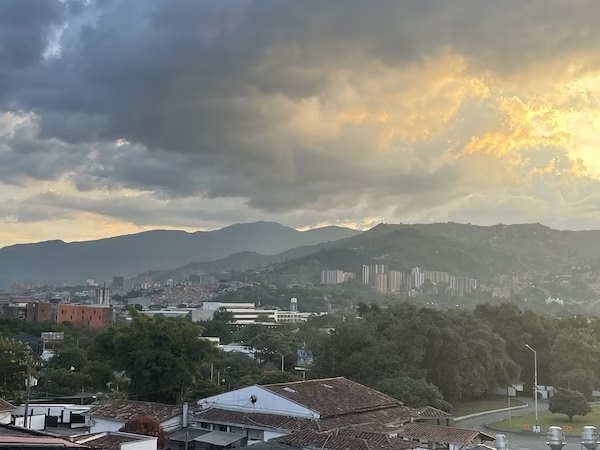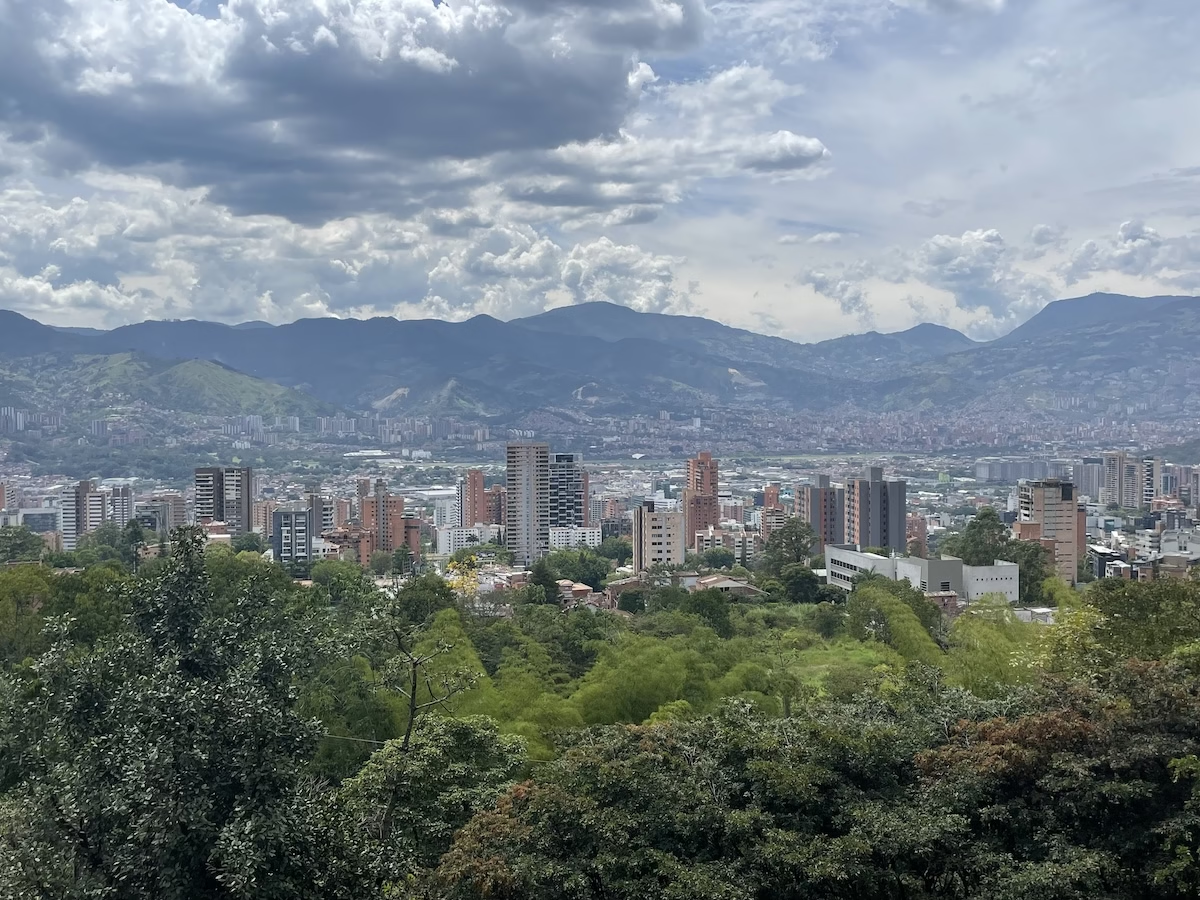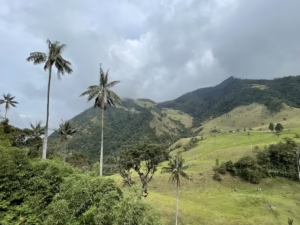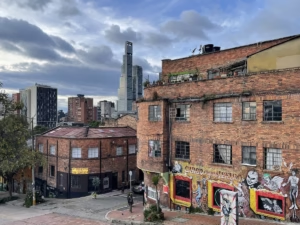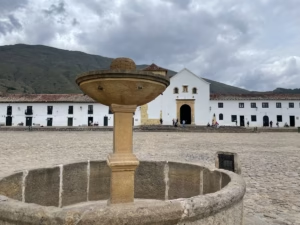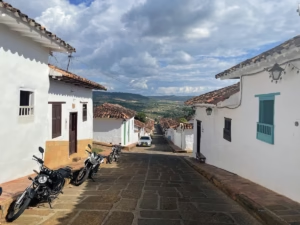Medellín is probably the most popular travel destination in Colombia. It might be one of the most popular in the world. The travel blogs, the guide books, the random guy in the hostel common room: they all talk about what an amazing city Medellín is. I’ve heard people say it’s their favorite city in the world.
I also liked Medellín. I especially liked hearing the story of how the city transformed itself from one of the most violent cities in the world into a glitzy destination for tourists, expats and digital nomads. We even extended our stay there by a week.
However, I think I would have liked it more if I hadn’t heard so much about how great it is. Sometimes all the hype can work against a place.
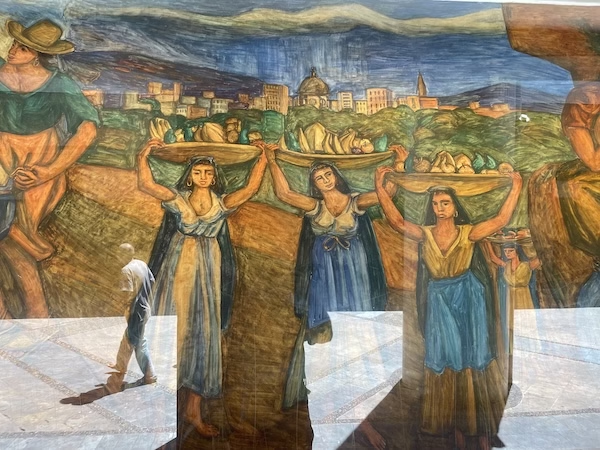
A Short History of Medellín
The Spanish founded Medellín back in the colonial era, although the area was originally inhabited by indigenous people. It’s the same old story of colonial conquest and destruction. Spanish colonial law forbade whites, indigenous and mixed-race populations from living together, which led to the founding of different villages for different races. One indigenous village was called El Poblado de San Lorenzo, which gave its name to the famous present-day El Poblado district.
The area’s economy first centered around gold mining and agriculture, although things didn’t really take off until after the industrial revolution. Medellín really hit it big during the after coffee came to town, due to its proximity to Colombia’s Eje Cafetero. Due to its relative late blooming, you won’t find a lot of Spanish colonial buildings in Medellín like you do elsewhere in Colombia.
Pablo Escobar and the Medellín Cartel
Of course, when you think about Medellín’s history, you probably aren’t thinking about industrial coffee production and architecture. To this day, when people think of Medellín’s past, they think of Pablo Escobar.
Escobar began his journey to become Colombia’s most infamous native son by selling cigarettes and fake lottery tickets. He worked his way up from these humble beginnings to become leader of a global drug cartel and one of the richest criminals in history. All those mountains of cocaine snorted by 80s rock bands probably came directly from Escobar and his Medellín cartel.
Escobar himself is weirdly kind of a folk hero here in the U.S. Especially in the hip-hop scene, with everyone from Nas to Kanye name-checking him at some point. It makes sense. The story of a man hustling his way from the bottom to the top of a criminal empire is basically the theme of all post-1996 get-rich-or-die-trying hip-hop culture.
And I guess to give Escobar some credit, he did also fund housing and some social programs in poor communities. He also murdered hundreds, if not thousands of people. That includes blowing up an airplane and killing all 107 passengers in order to get revenge on one guy.
I personally agree more with the point of view of the Colombians I spoke with. Escobar was, in the end, a terrible person, a criminal and a terrorist who would stop at nothing just for the sake of his own personal money and power. He was not a person to be idolized.
Pablo Escobar died in 1991 during a dramatic roof-top shoot out with the police. Unfortunately, he wasn’t the only one responsible for Medellín’s troubles.
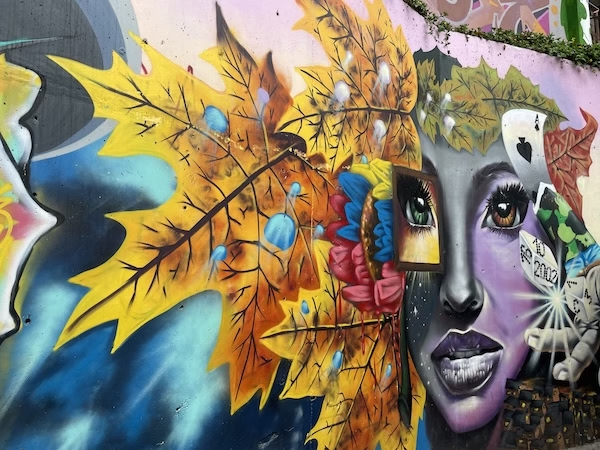
Comuna 13 and the Guerilla War
In addition to drug trafficking, Medellín was also a victim of violence related to Colombia’s decades long civil war. Thousands of people were displaced by the conflict and escaped to the edges of big cities. In Medellín, they had to settle in the steep mountainsides that surround the city, including areas like the famous Comuna 13.
Comuna 13 and other similar communities were incredibly poor. Think homes that are little more than shacks clinging precariously to the hillsides. Afterall, these people were refugees who escaped their villages with almost nothing.
The steep hillsides, however, provided a sort of natural defense. Guerilla groups such as the FARC and ELN followed the refugees and established bases in Comuna 13. They, in turn, were followed by paramilitary groups, bringing the violence of the civil war back to the poor people who were trying to escape it.
In 2002, then Colombian President Alvaro Uribe, with the backing of the United States under Plan Colombia, launched an offensive to crush the guerillas in Medellín. The military sent in tanks and soldiers and helicopters and heavily armed soldiers. The government soon declared victory.
However, that victory came at a horrible cost. Human rights groups have accused Uribe’s government (as well as other previous right-wing governments) of numerous human rights abuses. Some of these include claiming civilians were combatants in order to boost the number of enemy fighters they could declare dead. They tried to hide the bodies in a mass grave in a local trash dump.
Uribe also possibly had ties to right-wing paramilitary organizations, including some designated as terrorist groups by the U.S. Some of these paramilitaries were likely involved in the assault on Comuna 13. Some of these paramilitaries also have deep ties to the drug trade. Bribery charges related to Uribe’s paramilitary ties recently got him arrested.
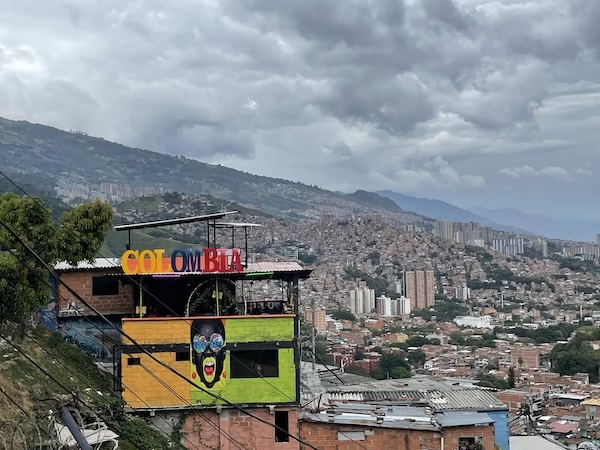
Medellín’s Recovery
The violence in Medellín peaked in the 1990s, when the city was considered the most dangerous in the world. In 1991 the murder rate was a whopping 381 per 100,000 residents. The city was a no-go zone for all but the most essential international travel. A local we spoke with told us about having to put mattresses up against his windows every night to stop the bullets.
Plan Colombia was widely regarded as a failure. However, Medellín began a program of social reform that’s led to more lasting change. The city owns a hydroelectric dam in nearby Guatapé, and it’s used sales of excess electricity to fund a number of social programs. Medellín has improved education, built public libraries and developed public transportation as a means to address the root causes of the crime and violence that’s long plagued the city.
I was surprised to learn how much of an effect the public transit system had. Suddenly, poor people from marginalized neighborhoods could go to work or school more easily. This opened a number of opportunities that didn’t exist before. Expansion of the metro to cable cars and even escalators going up the steep hillsides only helped more.
Of course, things are still far from perfect. Crime still exists. But Medellín’s murder rate today is only 13 per 100,000 residents. About the same as Denver, Colorado.
The city is nominated for, and wins, all sorts of awards for innovation and is now considered something of a global hot-spot.
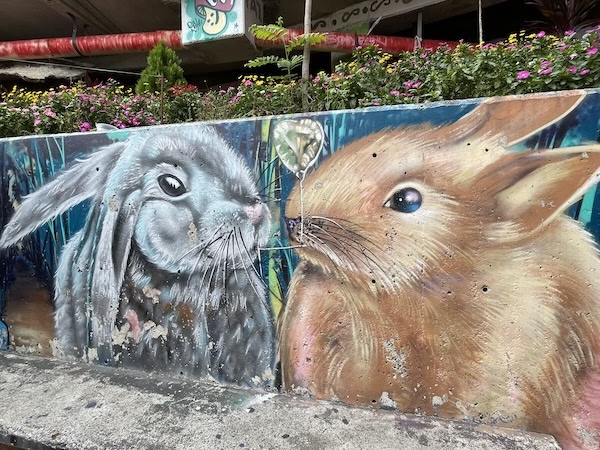
So, Is Medellín Safe?
When asking if Medellín is safe, go ahead and read the above statistic again. Medellín’s murder rate is about the same as Denver’s. Nobody worries about getting murdered when visiting Denver.
Of course, crime still happens. You will probably hear stories of people getting robbed. Muggings happen in Medellín, of course. They also happen in Denver. Generally, though, these robberies are crimes of opportunity. Unattended bags or cellphones. The Colombians say “don’t give papaya” which basically means to use your street smarts, don’t flash valuables and keep an eye on your crap.
Also, you shouldn’t buy drugs or hire prostitutes in Medellín. You shouldn’t do that anywhere, really. But, by buying drugs or soliciting prostitutes, you put yourself on the radar of criminals. It’s also unethical, immoral and contributes to a lot of social misery.
I never had a single issue in a week and a half in Medellín. Chances are, you won’t have any issues either. These days, I would say that Medellín is no sketchier or more dangerous than any other city of similar size.
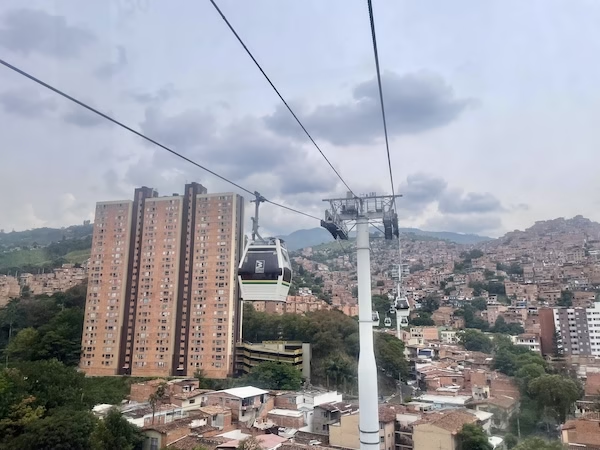
Transportation to and Around Medellín
Residents of Medellín are proud of their public transportation, and they should be. It’s easily the best in the country. In fact, it’s better than most cities in the U.S. The metro is safe, easy to use and easy to navigate. There are two main train lines, the A line running from north to south, and the B line running east to west. There are also numerous bus lines and cable cars, but the metro trains will get you to most places you’ll want to go. The cable cars will get you up to the hillside neighborhoods, and they’re also just kind of fun to ride anyway.
You can buy a Civica card, which works for all public transit, for about 10,000 pesos if you’re going to be in town for a bit. The official website has some more information in English.
Medellín also has plenty of taxis. I suggest using Cabify for cabs in Colombia. It works just like Uber or Lyft but you get connected to actually licensed taxi drivers.
Medellín is also pretty well connected to the rest of Colombia. Yes, there’s an airport, but Colombia’s long-distance buses are cheap and comfortable. They do take forever, though. Cartagena is 12 hours away, while Bogotá is about a 10-hour journey. Buses leave from either the north or south terminal. I used RedBus to book tickets ahead of time, but you can also buy them at the terminal.
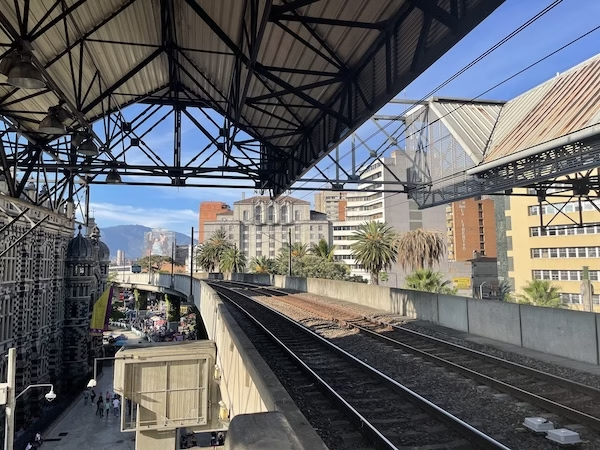
Where to Stay in Medellín
When we first got to Medellín, we stayed for three nights in Poblado Guesthouse in the famous El Poblado neighborhood. You can use this link to book a stay there, if you want, and this blog will get a small commission at no cost to you.
However, I absolutely loathed El Poblado. I’ll discuss it more later below, but needless to say it was not my kind of place. Everybody loves El Poblado, but it made me feel absolutely miserable.
After the hell of El Poblado, we moved to an Airbnb (Ugh, I know…) in the Laureles district and it felt like a breath of fresh air. I really liked Laureles.
Laureles still has its fancy side, and plenty of expats and digital nomads, but it doesn’t feel anywhere nearly as intense as El Poblado. You can walk a few blocks and find yourself surrounded by middle- and working-class Colombians just going about their daily lives. Laureles is also just a short-ways north of the Belén district, which is a cool, unpretentious neighborhood to explore.
Medellín’s downtown area is known as El Centro. I thought El Centro was fine to walk around during the day, but maybe a bit busy for sleeping. Other travelers we spoke with said they felt uncomfortable walking around there at night.
I would really recommend staying in Laureles if you’re traveling to Medellín. Click here to search for hotels or hostels.
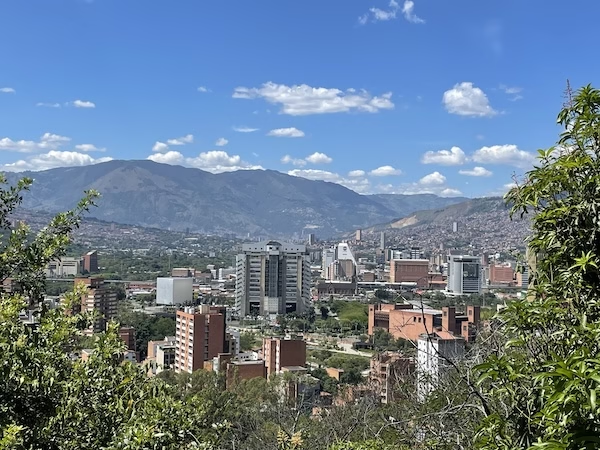
On one of the most fun, but also most stressful, aspects of travel is finding and booking places to stay. These days you have options ranging from dirt cheap hostel dorms to luxurious White Lotus style resorts. Thankfully, the internet is here to make finding accommodation easier.
Hostelworld is the go to app for finding hostels. For everything else, there’s Booking.com. If you book through either of the previous links, I’ll gain a small commission at no extra cost to you.
What to Do in Medellín
Medellín is a large city, and has all the large city things to see and do that you’d expect. There are obviously many more activities to occupy your time than just what’s listed here. Travelers rave about Medellín’s bar and restaurant scene. We mostly ate local, cheap, Colombian menu’s del día, but you can find all sorts of international cuisine.
Medellín’s nightlife is also famous, but as a someone who likes to get up early, I can’t comment on anything that happens after about 10pm. You could also see a fútbol (soccer) match, which would have been cool and I regret not doing this since we were staying about 10 minutes from the stadium. Maybe next time.
Take a Free Walking Tour
Most tourist cities worth their salt have free walking tours these days. While these tours are usually worthwhile anywhere, the free walking tour is especially essential in Medellín. This is where you can learn about Medellín’s fascinating history and recover in detail. The story of Medellín is really impressive, and it’s even more impressive to hear about it from someone who actually lived it.
We did our tour with Beyond Colombia, and I recommend it 100%. If you’ve never done a free walking tour before, the tour isn’t exactly free. You tip your guide based either on how well you think they did, or how guilty you feel about the wealth disparity between your country and theirs.
Do make sure to tip. There’s always that one asshole on every tour who leaves without tipping. Don’t be that asshole.
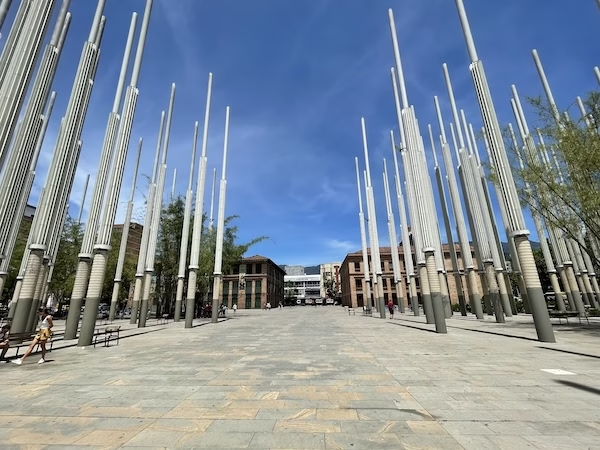
Take a Tour of Comuna 13
Comuna 13 is another fascinating case study in Medellín’s transformation. As I mentioned in the history section above, the neighborhood was once plagued by conflict and violence. Today, you would have no idea that this part of town used to be so dangerous.
In fact, today Comuna 13 is almost too touristy. The streets are lined with souvenir shops and there are piles and piles of crowded bars and hawkers. The whole thing leans a bit towards the tacky side. You can still see a lot of cool graffiti, but you can see that in most parts of Colombia. I wouldn’t even bother visiting Comuna 13 on my own.
However, on a tour, you get to hear the story behind the neighborhood. The story of Comuna 13’s violent clashes between the guerillas, paramilitaries and the government and its transformation to the tourist trap it is today is a fascinating one. It’s essential to hear it told from a local who can explain and give context to the whole thing. A guide will also be able to explain the meaning behind some of that cool graffiti.
Again, I would not bother with Comuna 13 without a tour guide.
Beyond Colombia offers paid tours of Comuna 13. You can also find and book tours through Get Your Guide. Book using this link and this website will get a small commission at no extra cost to you.
Be wary when booking tours, however. Make sure your guide is actually Colombian. We came across a woman from the United States “working” in Comuna 13 as a tour guide. She couldn’t even speak Spanish, and our guide had to translate for her.
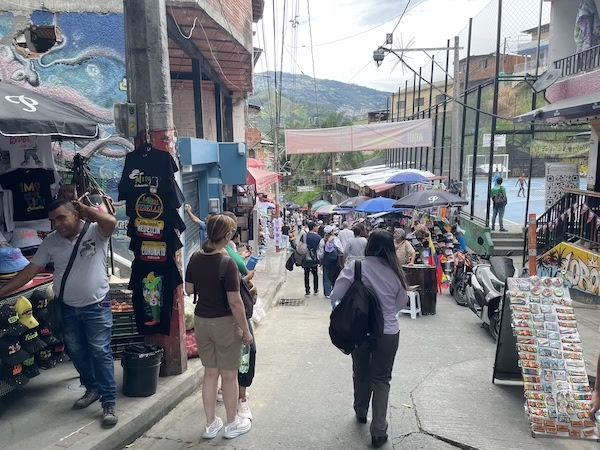
Visit Museo Casa de la Memoria
If you’re interested in learning more about Colombia’s civil war, then you should visit Museo Casa de la Memoria. This small museum in Medellín’s Centro district has a number of harrowing displays about what was once the world’s longest running civil conflict. It can give you more detail on the story of Comuna 13 and other similar neighborhoods. It’s kind of intense, and very sobering to visit.
Unfortunately, the museum’s displays are only in Spanish. You can find more information on the official website (also in Spanish).
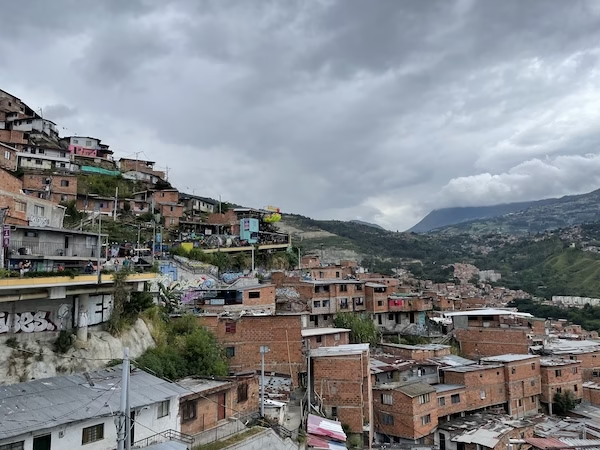
Take Spanish Lessons
If you’d like to better understand the museum’s displays, or if you’re traveling in Latin America long term and just want to have an easier time getting around, you’re going to need to speak Spanish. Colombians are generally very warm and friendly, but a lot of them don’t speak English.
While Medellín isn’t quite as great a value Spanish learning destination as Antigua, Guatemala, it’s still a decent place to take some lessons. We had a very good experience with Mr. Fox Spanish School located in the Laureles district of Medellín. The school was friendly, and the teachers were super helpful.
My only complaint is that they don’t offer a homestay program like you find in other Spanish schools. Otherwise, they were great. Visit their official website for more information: https://mrfoxspanish.com/
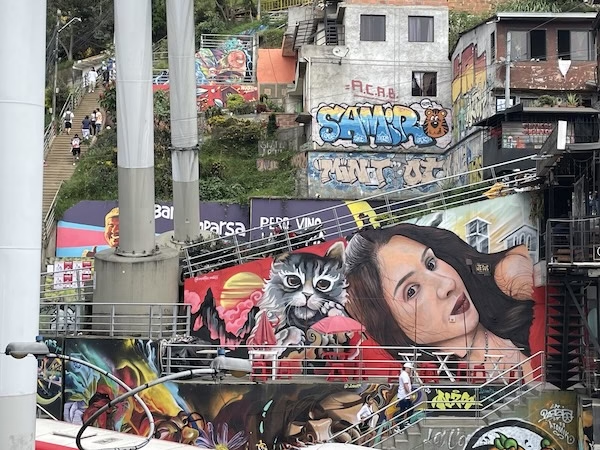
Visit the Museo de Antioquia and Plaza Botero
Chances are you may have seen some of the famous, rather rotund and fleshy, paintings and sculptures of Medellín’s most famous artist: Fernando Botero. If you haven’t, do yourself and look up some of his artworks. Their incredibly distinctive, but actually really cool.
Plaza Botero is located in Medellín’s Centro district and features a number of the artists bronze sculptures. The plaza is also a pleasant place to hang out and people watch.
You’ll find the Antioquia Museum, or Museo de Antioquia, just off Plaza Botero. This museum contains a whole lot more of Botero’s works, as well as a variety of other artists. I liked it a lot better than Medellín’s rather pretentious Museum of Modern Art. The official website (in Spanish) has more information.
Both the museum and the plaza are just north of the Parque Berrio metro station on line A.
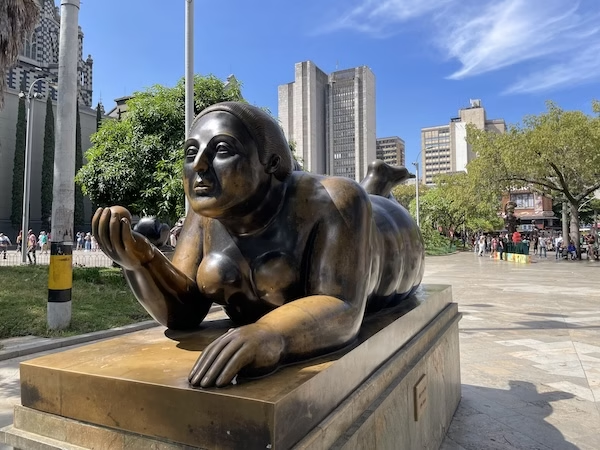
Hike in Parque Arvi
When you’re tired of wandering through concrete streets and towering brick structures, you’ll find Medellín actually has a fair amount of green space. The surrounding hills have a number of parks and forests. One of the most famous and most extensive is Parque Arvi.
Parque Arvi is located in the north-eastern mountains and has a number of trails winding through native Andean forest. You can see local birds and local families out having picnics. There are also restaurants and a pretty interesting, and sort of spooky, trail featuring creatures from local legends. It’s busy, but it’s a nice place to spend an afternoon.
Best of all, you can reach Parque Arvi through public transportation. Take the metro north to Acevedo station, then transfer to cable car Line K. Take that to Santo Domingo and transfer to Line L all the way to Parque Arvi.
The official website has information on hours and entrance fees. The website’s English option wasn’t working at the time I’m writing this.
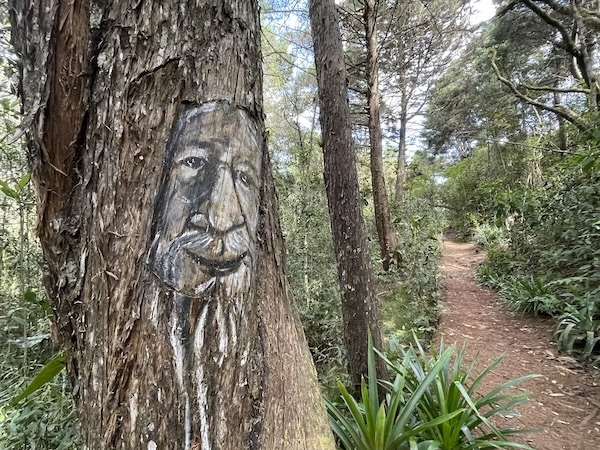
Climb up Cerro Nutibara Hill
Another option for those wanting a little outdoor time in Medellín is to visit Cerro Nutibara. This little city park is located on the south eastern edge of the Laureles district, and is a nice place to walk around for a couple of hours. There’s a sort of sculpture garden in the park, with some modern art dispersed among the trees.
At the top of the hill sits a replica of a local village. We didn’t go there, since we were planning to visit some actual local towns later in our trip. We walked to Cerro Nutibara, but you can also take metro line A to the Exposiciones station and walk west on Avenida 33.
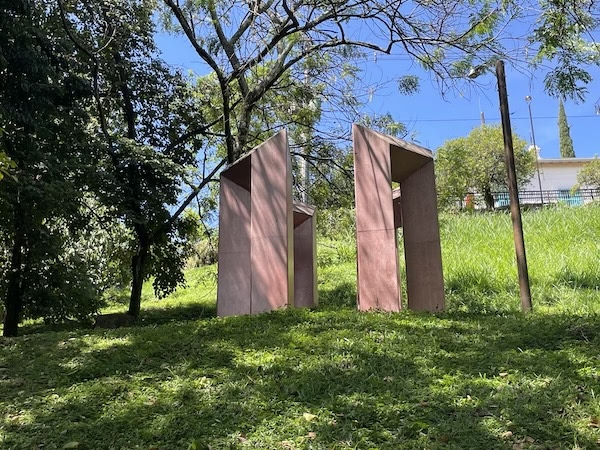
Visit the Botanical Garden
Medellín also has a nice set of botanical gardens if you’re still craving green space. They aren’t mind blowing, but they’re a pleasant place to wander around on a hot afternoon. It’s always fun to experience nature and see some local plant life up close.
You can reach the botanical gardens by taking metro line A to the Universidad station. Visit the official website (again, in Spanish) for hours, entrance fees and more information.
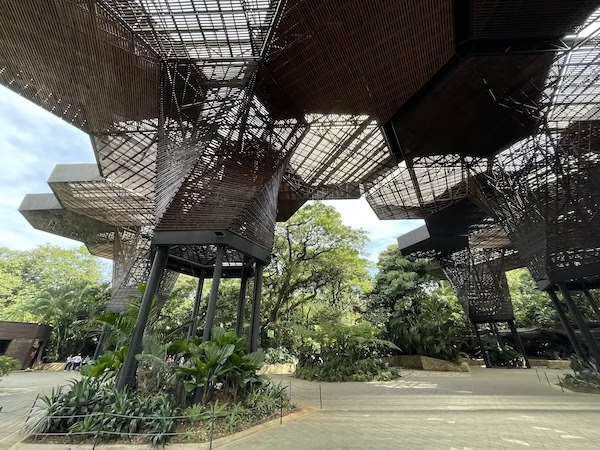
I usually like to travel and do activities independently, but sometimes you want to relax and let someone else take over. For those times, I suggest using Get Your Guide. Prices are reasonable and they have numerous tours available. Click here to explore options in Colombia. Tours booked through these links help support this blog at no extra cost to you.
What Not to Do in Medellin
Now that we’ve covered the best things to do in Medellín, let’s talk about what not to do in this city. I think that when we travel, we’ve got a certain responsibility to be as ethical as we can. Afterall, most of us are coming from rich countries with a long history of exploiting the poorer countries we’re visiting. There’s no need for us to exploit them further.
Aside from any ethical travel considerations, there are also some things that you shouldn’t do in Medellín because they’re just plain lame.
Don’t Bother Hanging Out in El Poblado
I really do not understand why everyone loves El Poblado. Nothing about this upper-class neighborhood appeals to me. It’s overpriced, flashy and dull. It’s full of snooty ex-pats and digital nomads, and everything in El Poblado feels like it’s built for snooty ex-pats and digital nomads rather than Colombians.
El Poblado has a lot of restaurants. These restaurants serve anything but Colombian food. Sure, some of them might taste good, but you can get the same exact food back home.
One area was full of luxury nightclubs that were all the sorts of places that would never let a slob like me behind their velvet ropes. I’m sure they’re fun, if your idea of fun is spending half your paycheck on champagne.
What mostly bothers me about El Poblado, though, is what bothers me about the whole snooty expat/digital nomad lifestyle. The goal is not to travel in order to learn about and experience new cultures. The goal is to travel in order to live like a rich person on a budget.
Colombia is significantly cheaper than the United States or Europe. Even though El Poblado is overpriced, it’s still cheaper than the United States or Europe. You can eat at fancy restaurants for the price of a normal restaurant back home. You can go out to fancy clubs for the price of a normal bar back home.
And you never once have to stop and consider that the reason everything is cheaper than back home is because the local people serving you food and drinks are making shitty wages.
The whole thing just feels creepy and exploitative to me. It feels like a new form of colonialism, and I don’t like it. You should visit Colombia because you’re interested in Colombia, not just because it’s cheap.
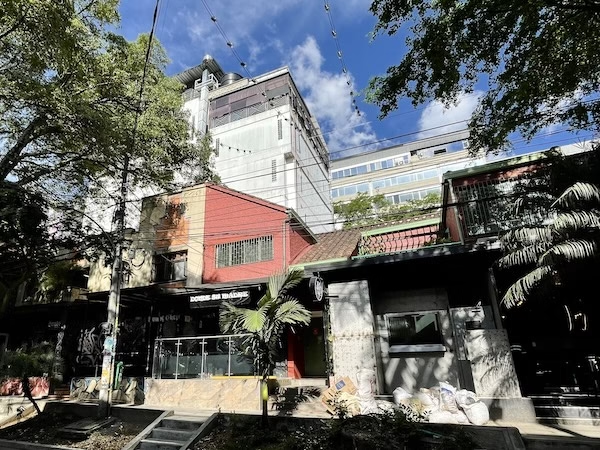
Don’t Hire a Non-Colombian Tour Guide
Speaking of dirty and exploitative things, I still can’t believe how many gringos we found who’d moved to Latin America to work as tour guides. We saw it in Costa Rica, and we saw it in Medellín. I already mentioned the woman running a Comuna 13 tour who didn’t even speak Spanish.
Working as a tour guide can be a really good gig for someone in a country with chronically high unemployment and low wages. Hiring local guides (and tipping them decently) is a fantastic way to give your tourist dollars directly to a local person. That guide, in turn, will go and spend that money in his or her community, pay taxes to the local government, and help boost the local economy overall. On top of that, going with a local guide can give you a unique perspective of a place you wouldn’t get from an outsider.
Hiring an “expat” from North America completely undercuts all that. These gringo guides might spend some of the money locally, but chances are they’re working on tourist visas and not paying taxes. They’re also taking work away from a local person who probably needs it a lot more.
Ironically, people in the United States have been complaining for years about undocumented Latinos coming and taking our jobs. Yet, in the United States, we generally have pretty low unemployment. Remember the whole “nobody wants to work anymore” thing?
In Latin America, however, the problem is the opposite. There are tons of people who want to work and not enough jobs. The gringo guides taking good work away from locals are doing way more harm than they probably realize.
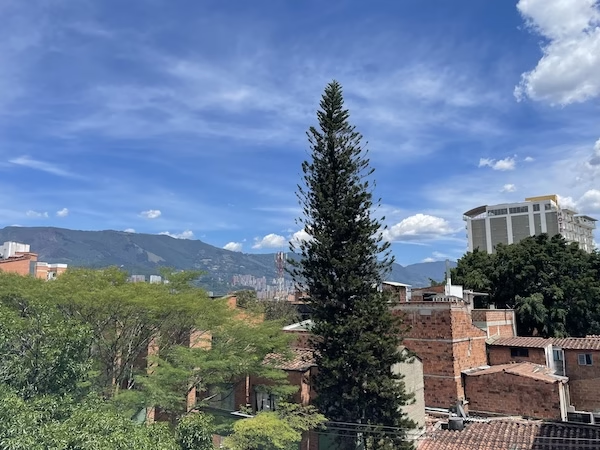
Don’t do Drugs
I shouldn’t have to mention this, but don’t do coke in Medellín. For one thing, as I mentioned in the safety section above, you risk putting yourself on the radar of some pretty bad dudes. For another thing, you’re supporting an industry that has brutalized and exploited people in Colombia for decades.
I don’t think you should do coke anywhere, for that matter. The drug industry thrives on demand from the United States and Europe. If you’re a casual user, just stop. If you’re an addict, get yourself in treatment.
On one of our walking tours, after discussing the vicious fallout of the drug trade in Colombia, somebody asked if there was anything we could do to help. The guide’s answer was simple. “Please stop buying drugs.”
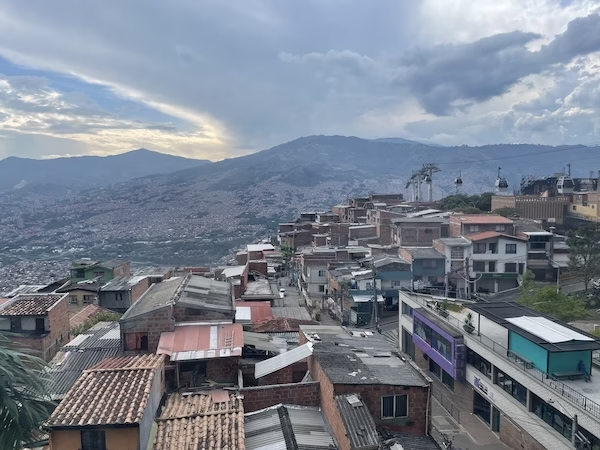
Don’t Go on a Pablo Escobar Tour
Speaking of drugs, you should avoid the temptation to go on a Pablo Escobar tour in Medellín. I understand that he’s an interesting figure, and it’s easy to develop a morbid fascination with people like Escobar. Also, there’s that whole Netflix show and resulting memes. Escobar tours, however, are just kind of tasteless if nothing else.
Escobar was a bad dude. He robbed and murdered and did all sorts of other horrible things just for money and power. He doesn’t deserve to be glorified.
On top of that, Colombians have been working hard in the last few decades to prove that there’s more to their country than kilos of white powder. And there really is. Colombia is a beautiful and fascinating country with a lot of amazing things to offer.
But those Escobar tours just reinforce those old stereotypes. They help glorify a drug kingpin who inflicted numerous wounds on Colombia. Wounds that are still healing. 1991 wasn’t all that long ago, and there are plenty of people in Medellín living today who have friends or family members killed as a result of Escobar’s drug empire.
Medellín deserves better than to have its past exploited for touristic entertainment.
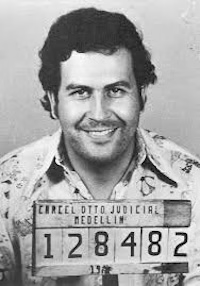
Final Thoughts on Medellín
The most amazing thing about Medellín is how it’s transformed and recovered from its violent past. The story of the city’s transformation from one of the most dangerous cities in the world to one of the most innovative and internationally recognized urban areas is a very cool story. I know some cities elsewhere that could learn from Medellín’s story.
However, I sometimes feel like I appreciate the story of Medellín more than the city itself. That’s not to say I didn’t like it. I liked it and I would go back if given the opportunity. But it just didn’t live up to the hype for me.
And maybe the hype was the main problem. You spend months reading and planning for a trip, and more months traveling and listening to people talk about a place like it’s heaven on earth. And then you get there and find out that it’s still just earth.
Maybe there’s a lesson here about mindfulness in traveling. The Buddhists say that you should approach each situation or experience mindfully, in order to observe it as it really is rather than what your preconceptions say it should be. This is excellent travel advice.
I went to Medellín with a head full of preconceptions, prepared to fall in love and want to move there. The reality, of Medellín was much different. I left the city thinking “meh, I liked Bogotá better.”
You should definitely visit Medellín if you’re traveling to Colombia. It’s a great city and very interesting. Just try to visit with a clear and open mind, free of expectations or preconceptions of how it should be. That is to say, don’t believe the hype. You’ll enjoy it more.
I liked Medellín, but I do have to say I liked Bogotá better.
